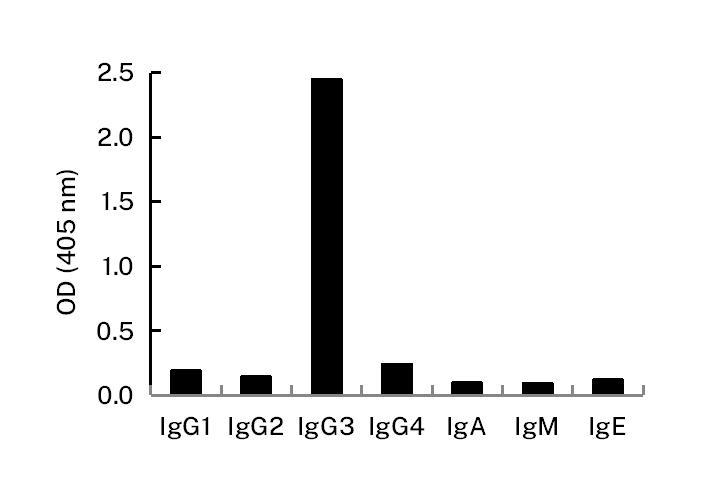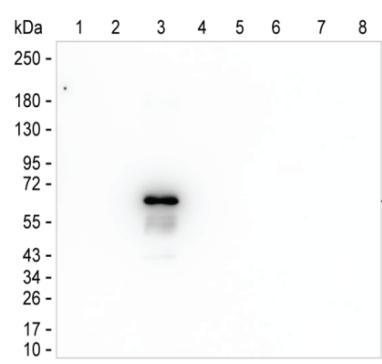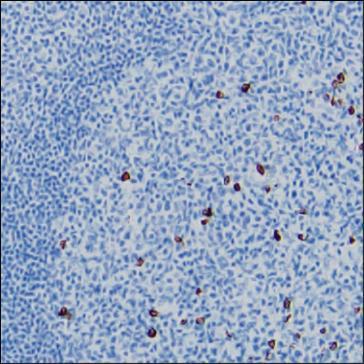


| WB | 咨询技术 | Human,Mouse,Rat |
| IF | 咨询技术 | Human,Mouse,Rat |
| IHC | 1/30000-1/40000 | Human,Mouse,Rat |
| ICC | 技术咨询 | Human,Mouse,Rat |
| FCM | 咨询技术 | Human,Mouse,Rat |
| Elisa | 咨询技术 | Human,Mouse,Rat |
| Host/Isotype | Mouse IgG1 |
| Antibody Type | Primary antibody |
| Storage | Store at 4°C short term. Aliquot and store at -20°C long term. Avoid freeze/thaw cycles. |
| Species Reactivity | Human |
| Immunogen | Recombinant human IgG3 |
| Formulation | Purified antibody in PBS with 0.05% sodium azide |
+ +
以下是关于人类IgG3抗体的3篇代表性文献及其摘要概括:
---
1. **文献名称**:*IgG subclasses and allotypes: from structure to effector functions*
**作者**:Vidarsson, G. et al.
**摘要**:
该综述系统比较了IgG各亚型(包括IgG3)的结构与功能差异,重点指出IgG3因铰链区较长,具有更强的补体激活能力和Fcγ受体结合活性,但其半衰期较短(因与FcRn结合能力弱于其他亚型)。
2. **文献名称**:*Fcγ receptor binding heterogeneity of human IgG3 allotypes*
**作者**:Bruhns, P. et al.
**摘要**:
研究通过体外实验揭示了IgG3不同同种异型(如G3m15和G3m21)与Fcγ受体(如FcγRIIIa)的结合差异,表明IgG3的遗传多态性直接影响其免疫效应功能,如抗体依赖性细胞毒性(ADCC)。
3. **文献名称**:*Enhanced clearance of HIV-1-infected cells by broadly neutralizing antibodies against HIV-1 in vivo*
**作者**:Ackerman, M.E. et al.
**摘要**:
研究发现,针对HIV-1的广谱中和抗体中,IgG3亚型因更强的Fc介导效应功能(如吞噬作用和补体激活),在清除病毒感染的细胞中表现优于IgG1.提示IgG3在抗病毒免疫治疗中的潜在优势。
---
**备注**:若需更近期或特定方向的文献,建议结合PubMed或Google Scholar按关键词检索(如“IgG3 FcRn”或“IgG3 infectious diseases”)。
Human immunoglobulin G3 (IgG3) is one of the four subclasses of IgG antibodies, playing a distinct role in adaptive immunity. It constitutes approximately 5-8% of total serum IgG and is characterized by a uniquely long hinge region, contributing to its structural flexibility and functional diversity. This extended hinge enhances antigen-binding avidity and facilitates interactions with immune cells, though it also makes IgG3 more susceptible to proteolytic cleavage compared to other IgG subclasses.
IgG3 exhibits strong effector functions, including high affinity for activating Fcγ receptors (FcγRI, FcγRIIa, FcγRIIIa) and potent complement activation via the classical pathway. These properties make it particularly effective in neutralizing pathogens, opsonizing targets for phagocytosis, and triggering inflammatory responses. However, its short serum half-life (~7–8 days vs. ~21 days for IgG1) limits its persistence in circulation.
Genetically, IgG3 is encoded by the IGHG3 gene on chromosome 14q32. Polymorphisms in its heavy chain constant region contribute to interindividual variability in immune responses. Clinically, IgG3 is associated with protection against encapsulated bacteria, viruses (e.g., HIV, influenza), and parasites. Conversely, it has been implicated in autoimmune disorders (e.g., lupus) and alloimmune reactions due to its proinflammatory potential.
Recent research explores engineering IgG3-based therapeutics to leverage its potent effector mechanisms while addressing stability challenges, highlighting its untapped potential in immunotherapy.
×